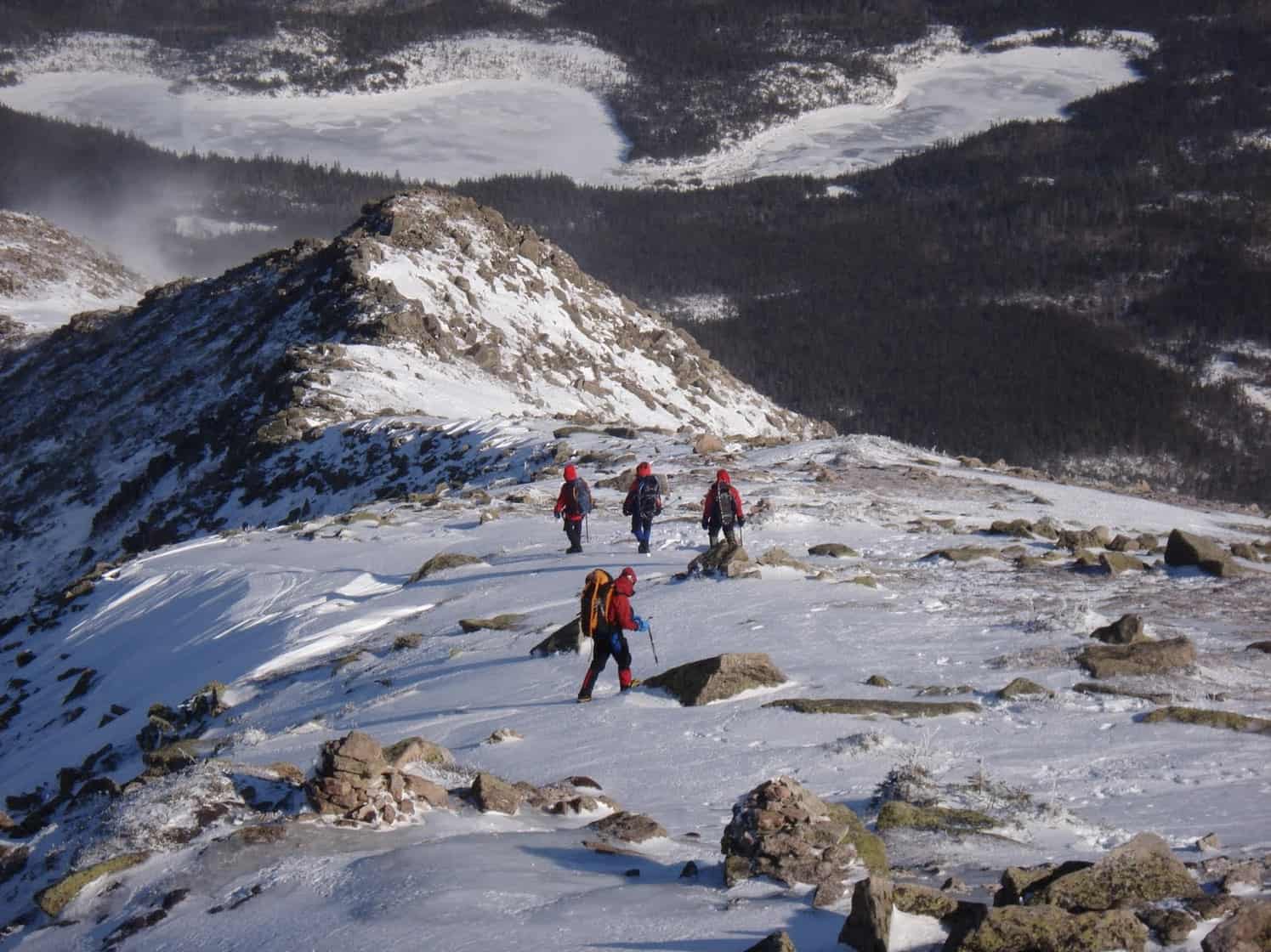Backpacking Gear
Whether you’re headed out for a summer camping trip or a winter weekend in the mountains, having the right gear is essential. Here’s what you should pack to be prepared for every season.
3-Season Backpacking Gear List:
Ideally aim for a total weight of 20 to 30 lbs., including food and water, for trips of 2-4 days in the spring, summer, and fall. This list covers most of the items, but check with the trip leader to see if there is anything to add or omit. Some gear (tents, filters, stoves, ropes, etc.) can be shared to reduce weight. Try to keep your pack as light as possible without sacrificing safety and/or comfort.
Your four main items (for summer only) should weigh no more than 10 lbs. combined: backpack, tent and optional footprint, sleeping bag, and sleeping pad. Make a list and weigh every item. In cooler temperatures you will need a thicker/heavier sleeping bag and sleeping pad. Try to stay in the following weight ranges:
- Pack: 2-4 lbs.
- Tent: 2-3 lbs.
- Sleeping bag: 2 lbs.
- Sleeping pad: 1 lb.
Gear that is very light is also very expensive. You may find it more appropriate to start with gear that is a little heavier to stay within your budget. It’s better to start your backpacking experience with rented or borrowed gear so that you can better choose what will work best for you. Once you have a better understanding of that you will be able to save up to purchase the best quality and lightest gear you can afford.
NO COTTON CLOTHING! Cotton, when wet, dries slowly, provides no insulation, can cause blisters, and is heavy. Therefore, all clothing from head to toe, should be lightweight merino wool or synthetic. In particular, jeans are not appropriate for backpacking.
| REQUIRED | OPTIONAL | |
| Backpack | Capacity of 2500-4000 cubic inches (40-65 liters) | Small lightweight day pack for hikes from base camp |
| Waterproof pack cover (or line pack with unscented garbage bag and put clothing and sleeping bag in compression stuff sacks inside) | ||
| Shelter | Seam-sealed tent, tarp or hammock with rain fly | Tarp for kitchen or rain shelter [1] |
| Ground sheet or footprint [1] | ||
| Sleeping Bag | The temperature rating for your sleep system (sleeping bag or quilt) should be down to 15° to 25° F spring or fall, and 30° to 40° summer | Sleeping bag liner |
| Sleeping pad. In the summer you can get by with an inflatable pad. In colder weather you will want a closed-cell pad under you to better insulate you from the ground. | ||
| Clothing | Broken-in waterproof backpacking boots or shoes | Lightweight camp/water shoes. (Some leaders may require water shoes if there are stream crossings on your trip.) |
| 2-3 pairs of wool or synthetic socks and optional thin liner socks | ||
| 1 pair nylon or wool hiking shorts or pants | Wicking underwear (non-cotton) | |
| Synthetic or merino wool T-shirt | Synthetic or merino wool long-sleeve shirt | |
| Sun or rain hat | ||
| Waterproof, breathable rain jacket and pants | Gaiters | |
| Base layer/Insulating layer | ||
| Lightweight wool or fleece hat | ||
| Lightweight wool or fleece gloves | ||
| Food | Breakfasts, lunches, dinners, snacks, and beverages [2] | |
| Stove and fuel [1] | ||
| Lighter or matches in waterproof container | ||
| Small, lightweight cooking pot [1,2] | ||
| Cup/bowl, spork/cutlery (avoid metal in cold weather) | ||
| Stuff sack and rope for bear bag [1]
A bear canister is required/recommended in some areas. Check with leader before trip to make sure. See rental list below for some places to rent/purchase canisters. Learn more about the reasons for using a canister here. |
||
| Resealable plastic bags or small trash bags | ||
| Water | 2-3 quarts/liters
Water filter or purification tablets[1] |
|
| Water sack or collapsible container | ||
| Health/Safety | Map and compass | Guidebook |
| Whistle (plastic) | Seat pad | |
| Headlamp and extra batteries | ||
| Swiss Army Knife or small multi-tool | ||
| Bandana or small pack towel | ||
| Sun protection/sunglasses | ||
| Bug protection | ||
| Personal toilet items [3] | ||
| First Aid Kit [4] | ||
| Repair Kit [5] | ||
| Miscellaneous | Book/magazine | |
| Candle lantern | ||
| Camera | ||
| Notebook/sketchbook and pencil | ||
| Playing cards | ||
| Spare pair of eyeglasses |
[1] May be shared, but don’t rely on others. Bring to the trailhead.
[2] As needed, read the trip plan carefully.
[3] Including toilet paper, trowel, and plastic bags to pack out used toilet paper
[4] Moleskin, bandages, ibuprofen, and other over-the-counter medications, prescription medications
[5] Duct tape, needles and thread, safety pins, patches.
Winter Backpacking Gear List
Winter travel outdoors presents the serious risks of frostbite and hypothermia. In addition, the outdoor traveler has to be warm to enjoy the experience. Here’s what you should bring.
Clothing
- Winter boots (boots with a removable liner of insulation like double plastic mountaineering boots or Pac boots are strongly recommended and required by some winter leaders. There are a wide variety of these boots on the market and not all are good ones. Discuss your boots with your trip leader to ensure they are acceptable.) You need to be using some form of vapor barrier socks or plastic bags to keep the insulation dry in all boots.
- Vapor barrier socks (A plastic bag over your feet will protect the boot insulation from foot sweat)
- Thick down/synthetic jacket with hood and pants for camp (and carrying as safety gear for ascents in as warm of material as you can afford), in addition to the three layers of base, insulation, and shell. This gear is meant for standing around without exercising. Multiple layers are acceptable to achieve lots of protection.
- Winter hat and balaclava (bring a spare for more insulation or in case one is lost)
- Wind-proof face mask and goggles if appropriate for the trip
- Mitten shells and liners, in addition to glove liners (add thin liner gloves to handle metal like stoves)
- Snowshoes (Some snowshoes work better in mountainous terrain than others. Discuss with your trip leader if your snowshoes are appropriate for the terrain.)
- Crampons/microspikes as appropriate for the intended trip
- Trekking poles/ice ax as appropriate for the intended trip
Camping gear
- -10° to -30° Fahrenheit sleeping bag
- Vapor barrier, if sleeping bag is down which will keep you warmer by keeping moisture and body oils out of the down insulation
- Two to three sleeping pads, usually one or two closed cell and one inflatable (the more insulation under you the warmer you will sleep)
- Foam sit pad to sit or stand on during meals (being insulated from the snow will keep you warmer)
- Stove base to keep your stove from melting into the snow and improve stability.
- Winter stove (liquid fuel only, canister stoves do not work well in cold temperatures. You will typically need 10 ounces of fuel per person per day.)
- Large pot to boil water (in the winter all drinking water needs to be boiled)
- Vacuum bottle (use it for a hot drink in the morning while waiting for the first pot of water to boil or upon arrival back in camp at the end of the day)
- Water bottle insulation (will keep your water hot/warm longer)
- Insulated mug
- Insulated food container – If eating freeze dried food, it keeps it warm while rehydrating and while you are eating.
- Bring more food than you can imagine eating. Winter travel requires 5,000 to 6,000 calories a day.
How to stay warm while winter backpacking
The most difficult time to stay comfortable for many people is in camp at the end of the day, before climbing into the sack. Here are some suggestions:
- Carry a towel to dry off and change clothes immediately upon making camp.
- Drinking something hot is a great help in the first 30 minutes. This can be in the vacuum bottle from breakfast.
- If possible, avoid drinking cold water in camp.
- Right before going to bed take a quick short walk to heat yourself up before the transition to a cold sleeping bag.
- Take a little chocolate to bed with you in case you wake up cold during the night.
- Side zippers in layers for the legs allow you to change layers without removing boots.
- A good source for winter backpacking information is ADK’s Winter Mountaineering School Student Handbook. This program used to be jointly sponsored with the AMC. Here is the weekend backpacking checklist. You might also contact them for good winter mountaineering training at: ADK Winter Mountaineering School
- A good book reference is: Mountaineering: The Freedom of the Hills.
Where can I rent backpacking equipment?
New York City area:
EMS, Bridgewater, NJ
Backpacks, sleeping bags, pads, tents.
Gear to Go Outfitters, Buchanan, NY
Tents, sleeping bags down to 0 F, pads, packs, snowshoes, crampons, trekking poles, microspikes, bear canisters, headlamps, stoves, pots, bowls, cups, water filters, compass.
Catskills Area:
Rock & Snow, New Paltz, NY
Snowshoes, summer and winter boots, tents, packs, sleeping bags down to +5F, crampons, trekking poles, microspikes.
EMS, Lake Placid, NY
Sleeping bags, pads, tents, snowshoes, bear canisters.
ADK, North Elba, NY
Bear canisters, snowshoes, microspikes.
White Mountains area:
EMS, North Conway, NH
Packs, sleeping bags, pads, tents, mountaineering boots and crampons, snowshoes. and poles.
IME, North Conway, NH
Double mountaineering boots, tents, packs, sleeping bags down to -30F, crampons, various clothing items, snowshoes, trekking poles, ice axes, microspikes.
National (shipped to your home):
Outdoors Geek, Denver CO
Sleeping bags down to -20F, tents, pads, snowshoes, stoves, pots, water filtration, packs, bear canisters, summer boots.
Wild Ideas, Union WA
Bearikade bear canisters

